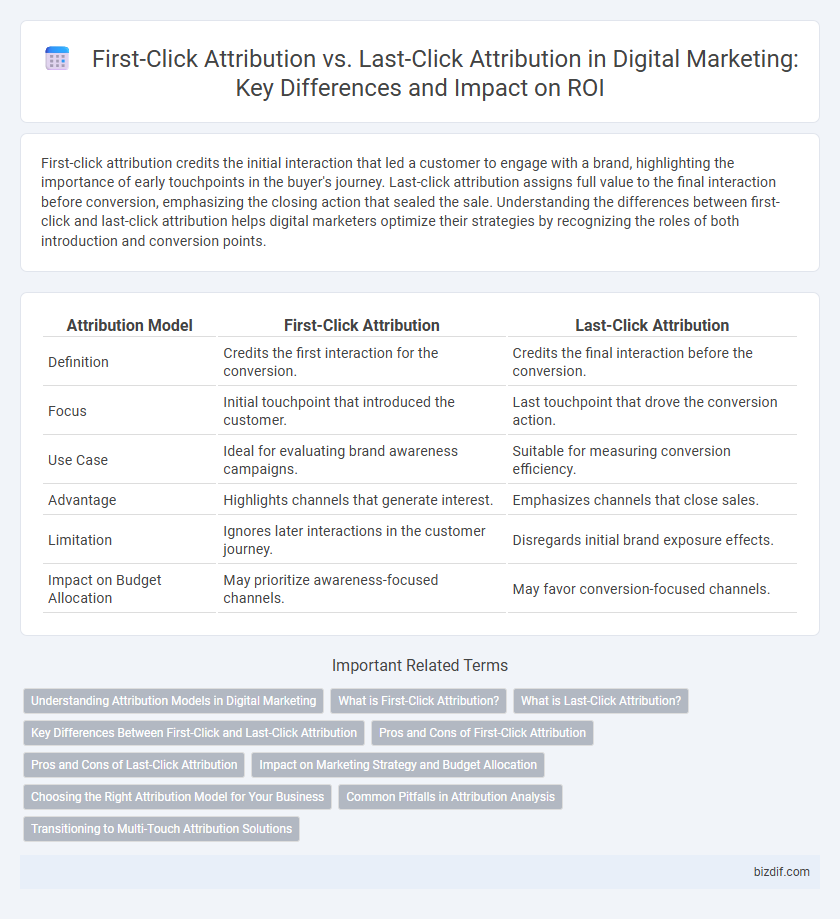First-click attribution credits the initial interaction that led a customer to engage with a brand, highlighting the importance of early touchpoints in the buyer's journey. Last-click attribution assigns full value to the final interaction before conversion, emphasizing the closing action that sealed the sale. Understanding the differences between first-click and last-click attribution helps digital marketers optimize their strategies by recognizing the roles of both introduction and conversion points.
Table of Comparison
| Attribution Model | First-Click Attribution | Last-Click Attribution |
|---|---|---|
| Definition | Credits the first interaction for the conversion. | Credits the final interaction before the conversion. |
| Focus | Initial touchpoint that introduced the customer. | Last touchpoint that drove the conversion action. |
| Use Case | Ideal for evaluating brand awareness campaigns. | Suitable for measuring conversion efficiency. |
| Advantage | Highlights channels that generate interest. | Emphasizes channels that close sales. |
| Limitation | Ignores later interactions in the customer journey. | Disregards initial brand exposure effects. |
| Impact on Budget Allocation | May prioritize awareness-focused channels. | May favor conversion-focused channels. |
Understanding Attribution Models in Digital Marketing
First-click attribution assigns full credit to the initial touchpoint that introduced the customer to a brand, emphasizing the importance of awareness channels in digital marketing campaigns. Last-click attribution attributes the entire conversion value to the final interaction before purchase, often prioritizing retargeting ads and direct response efforts. Understanding these models allows marketers to optimize budget allocation, evaluate channel performance accurately, and enhance the overall customer journey analysis in digital marketing strategies.
What is First-Click Attribution?
First-click attribution assigns 100% of the conversion credit to the initial interaction a customer has with a brand, highlighting the importance of the consumer's entry point in the marketing funnel. This model helps marketers identify which channels or campaigns are most effective at generating brand awareness and driving the first engagement. Understanding first-click attribution enables more strategic budget allocation toward acquisition-focused digital marketing efforts such as paid search, social media, and display advertising.
What is Last-Click Attribution?
Last-click attribution is a digital marketing model that assigns 100% of the credit for a conversion to the final interaction or touchpoint before the purchase or desired action. This approach helps marketers understand which channel or campaign directly influenced the customer's decision at the end of the buying journey. Though simple to implement, last-click attribution can overlook the impact of earlier touchpoints that contributed to brand awareness and customer engagement.
Key Differences Between First-Click and Last-Click Attribution
First-click attribution assigns 100% of the conversion credit to the initial touchpoint, highlighting the channel that introduces the customer to the brand. Last-click attribution gives full credit to the final interaction before conversion, emphasizing the channel that closes the sale. The key difference lies in how each model values the customer journey, with first-click focusing on awareness generation and last-click prioritizing conversion drivers.
Pros and Cons of First-Click Attribution
First-click attribution assigns full credit to the initial interaction that led a customer to a digital marketing funnel, providing valuable insights into which channels effectively generate awareness and initial interest, such as display ads or social media. It benefits marketers by highlighting the effectiveness of top-of-funnel strategies but can undervalue critical touchpoints closer to conversion, like email campaigns or retargeting ads. However, relying solely on first-click attribution may result in misallocating budget away from converting channels, limiting the accuracy of performance measurement in multi-channel customer journeys.
Pros and Cons of Last-Click Attribution
Last-click attribution credits the final touchpoint before conversion, offering straightforward insight into which channel closes the sale, aiding budget allocation and campaign optimization. Its simplicity can oversimplify the customer journey, neglecting upper-funnel efforts like awareness and consideration that contribute to initial engagement. This attribution model risks undervaluing channels such as social media or content marketing that play critical roles earlier in the funnel, potentially skewing strategy and investment away from impactful awareness drivers.
Impact on Marketing Strategy and Budget Allocation
First-click attribution credits the initial interaction for customer conversion, driving marketing strategies to prioritize brand awareness and top-of-funnel channels such as social media and content marketing. Last-click attribution assigns full value to the final touchpoint, often resulting in increased budgets for direct response tactics like paid search and retargeting campaigns. Understanding these models influences budget allocation by either investing heavily in early-stage engagement or optimizing for channels that close sales, ultimately shaping campaign focus and ROI measurement.
Choosing the Right Attribution Model for Your Business
Choosing the right attribution model depends on your customer's journey complexity and marketing channels involved. First-click attribution assigns credit to the initial interaction, ideal for businesses focused on lead generation and awareness, while last-click attribution credits the final touchpoint, suitable for sales-driven objectives or shorter sales cycles. Evaluating your conversion paths and campaign goals ensures a tailored attribution strategy that maximizes marketing ROI and informs budget allocation effectively.
Common Pitfalls in Attribution Analysis
Common pitfalls in attribution analysis include over-reliance on either first-click or last-click attribution models, which can lead to skewed understandings of customer journeys. First-click attribution often undervalues touchpoints that influence conversion at later stages, while last-click attribution ignores earlier interactions that build awareness. Accurate digital marketing strategies require multi-touch attribution models to capture the full impact of all engagements throughout the buyer's journey.
Transitioning to Multi-Touch Attribution Solutions
Transitioning to multi-touch attribution solutions enhances accuracy by capturing the entire customer journey rather than relying solely on first-click or last-click models. Multi-touch attribution assigns value to multiple touchpoints, providing a holistic view of digital marketing effectiveness across channels. Implementing advanced attribution tools like machine learning algorithms enables marketers to optimize budget allocation and improve ROI by understanding the true impact of each interaction.
First-click attribution vs Last-click attribution Infographic

 bizdif.com
bizdif.com